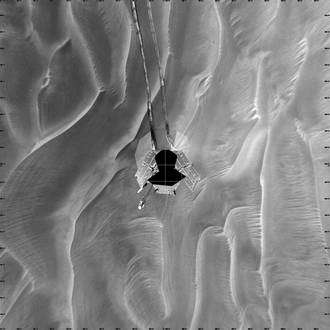Opportunity Begins Careful Rollout

Opportunity rotated its wheels on sol 463 for the first time since the rover dug itself into a sand dune more than two weeks earlier. The wheels made about two and a half rotations, as commanded, and the results were a good match for what was expected from tests on Earth. In the loose footing, the rover advanced 2.8 centimeters (1.1 inch) forward, 4.8 millimeters (0.19 inch) sideways and 4.6 millimeters (0.18 inch) downward. After further analysis of the results, the rover team will decide whether to repeat the same careful movement again on sol 465. Meanwhile Opportunity's main tasks for sol 464 were remote-sensing observations.
Image: This mosaic of navigation-camera frames from NASA's Mars Exploration Rover Opportunity, presented in a vertical projection, shows the rover's position after it dug itself to wheel-hub depth in a small dune during its 446th martian day, or sol (April 26, 2005). The elongated dune, or ripple, is about one-third of a meter (one foot) tall and 2.5 meters (8 feet) wide. Image Credit: NASA/JPL
Opportunity had completed nearly 40 meters (131 feet) of a planned 90-meter (295-foot) drive that sol when its wheels began slipping. The rover was driving backwards at the time. The rover team frequently alternates between backwards and forwards driving to keep wheel lubrication well distributed. The wheels kept rotating enough times to have covered the rest of the distance if they hadn't been slipping, but the rover eventually barely inched forward. After a turn at the end of the planned drive, Opportunity sensed that it had not turned properly and stopped moving.
The rover team spent more than a week designing and conducting tests under simulated Mars conditions on Earth before choosing the best way for Opportunity to drive out of the dune.
Source: NASA

















